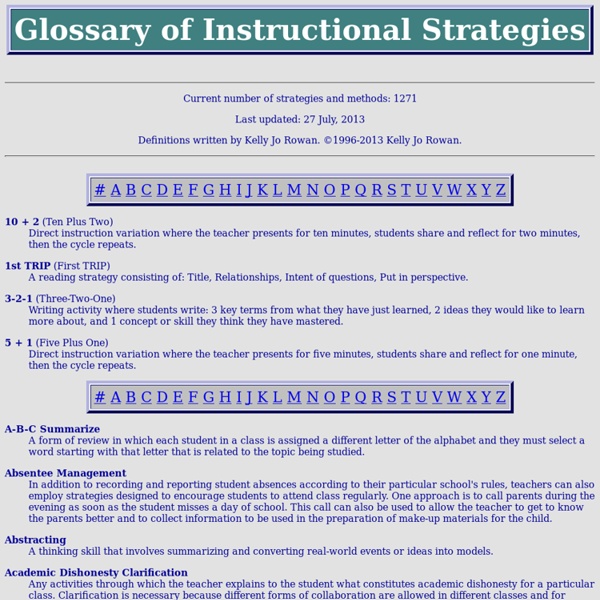A List Of 50+ Teaching Strategies To Jumpstart Your Teacher Brain
Teaching strategies are among the most important ingredients for highly-effective learning environments. In addition to literacy strategies, approaches to assessment, and grouping strategies (among many others), knowing the right teaching strategy for the right academic situation may not be a matter of expertise or training, but memory: out of sight, out of mind, yes? Which makes the following infographic from fortheteachers.org useful. While it doesn’t offer definitions and explanations for each strategy (it’s an infographic, not a book), and many great strategies are missing (e.g., 3-2-1, exit slip, project-based learning, accountable talk, ask a question, etc.) it does work well as a kind of reminder for what’s possible, even offering categories for each strategy, from progress monitoring (think-pair-share, KWL charts), to Note-Taking (graphic organizers). There are 87 instructional strategies listed below, but several are repeated across categories, so let’s call it “50+” strategies.
Differentiated Instruction Made Easier
Shuana Jordan Product Manager Differentiated instruction creates a learning environment that motivates students to learn and helps meet the diverse needs of individual students. Technology supports differentiated instruction and provides the opportunity to improve teaching and learning. Below are instructional strategies that will encourage differentiated instruction, along with examples of how to apply these basic strategies and recommendations for supporting technology. Tiered strategy
20 Differentiated Instruction Strategies & Examples
As students with diverse learning styles fill the classroom, many teachers don’t always have the time to plan lessons that use differentiated instruction (DI) to suit their distinct aptitudes. This can involve adjusting: Content — The media and methods teachers use to impart and instruct skills, ideas and informationProcesses — The exercises and practices students perform to better understand contentProducts — The materials, such as tests and projects, students complete to demonstrate understanding To help create lessons that engage and resonate with a diverse classroom, below are 20 differentiated instruction strategies and examples.
What Is Active Learning?
Defining "active learning" is a bit problematic. The term means different thing to different people, while for some the very concept is redundant since it is impossible to learn anything passively. Certainly this is true, but it doesn't get us very far toward understanding active learning and how it can be applied in college classrooms. We might think of active learning as an approach to instruction in which students engage the material they study through reading, writing, talking, listening, and reflecting.
Instructional Strategies List for Teachers
A BIG List of Instructional Strategies for Teachers I’ve decided to create an instructional strategies list for teachers. There are plenty of teaching textbooks meant to provide instructional strategies for teachers. There are also huge lists of
8 Exam-Prep Activities Students Actually Like
After Christmas break students will return to school for 8 days of review prior to taking their End of Course Exams. I can give my students a review packet with hundreds of problems, but that would only lead to them giving up, sleeping, and not even trying. So below are 8 fun activities I created to motivate and engage my students in their final exam reviews. 1. Vocabulary Gallery Walk – Each student will be given a word to define and provide an example for.
Classroom Management Strategies
Get instant ideas from other teachers on how to manage your toughest behavior challenges. Just click on a behavior issue below. How can a teacher prevent irritating classroom behaviors? 1.
Instructional Strategies for Online Courses
Instructional Strategies for Online Courses Effective online instruction depends on learning experiences appropriately designed and facilitated by knowledgeable educators. Because learners have different learning stylesor a combination of styles, online educators should design activities multiple modes of learning in order to provide significant experiences for each class participant. In designing online courses, use multiple instructional strategies. Teaching models exist which apply to traditional higher education learning environments, and when designing courses for the online environment, these strategies should be adapted to the new environment. Traditionally, in a teacher-centered classroom, instructors control their environment because they have a monopoly on information.
Effective Instructional Strategies That Boost Learning
Instructional strategies include all approaches that a teacher may take to engage students in the learning process actively. These strategies drive a teacher's instruction as they work to meet specific learning objectives and ensure that their students are equipped with the tools they need to be successful. Effective instructional strategies meet all learning styles and the developmental needs of all learners. Teachers must be equipped with a well-rounded arsenal of effective instructional strategies to maximize their effectiveness and to increase student learning opportunities.




More instructional strategies. Always good to have as many as possible at arms reach. by tiffanygalanis Jul 24